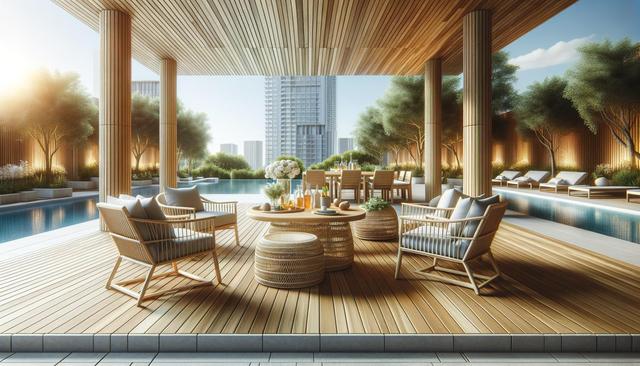Understanding the Basics of Outdoor Furniture Design
Outdoor furniture design combines aesthetics, functionality, and durability to create inviting environments in open-air settings. Unlike indoor pieces, furniture designed for the outdoors must withstand varying weather conditions, from intense sun to heavy rain. This is why materials like teak, aluminum, and all-weather wicker are frequently used. These offer resistance to moisture and temperature changes while maintaining their look over time.
Designs range from classic wooden benches to contemporary modular lounge sets, and the choice often depends on your space and intended use. For example, if you’re furnishing a small balcony, foldable or stackable chairs and compact tables are practical. On the other hand, large patios may benefit from sectional sofas, daybeds, and dining sets that encourage gatherings.
Key considerations in selecting outdoor furniture include:
- Material durability and maintenance
- Comfort and ergonomics
- Visual appeal and style cohesion
- Weather resistance and UV protection
By understanding these basics, you can make informed choices that blend seamlessly with your home’s architecture and your lifestyle needs.
Wood, Metal, or Wicker? Choosing the Right Material
One of the most significant decisions when selecting outdoor furniture is choosing the right material. Each has its unique characteristics, benefits, and care requirements. Wood, particularly hardwoods like acacia and eucalyptus, offers a rich, natural look and can last for years with proper maintenance. However, it usually requires seasonal sealing or oiling to maintain its appearance.
Metal options like aluminum and stainless steel are prized for their modern appeal and resistance to rust. Aluminum is lightweight and easy to move, making it ideal for rearranging based on different occasions. Wrought iron, while heavier, offers a classic look but may need occasional repainting to prevent corrosion.
Wicker, especially synthetic resin wicker, has become a popular choice due to its lightweight yet durable construction. It mimics the look of traditional rattan but stands up better to moisture and UV exposure. Consider the following when choosing materials:
- Wood: Warm and natural, but requires upkeep
- Metal: Sleek and durable, may need cushions for comfort
- Wicker: Lightweight and versatile, often paired with cushions
Match the material with your climate and how much time you’re willing to spend on maintenance to ensure long-lasting satisfaction.
Design Styles That Fit Every Outdoor Setting
Outdoor furniture designs come in a wide array of styles, allowing you to reflect your personal taste while complementing your exterior space. From rustic charm to sleek modernism, the right style enhances not just comfort but also the overall ambiance of your yard or patio.
Minimalist designs feature clean lines and neutral tones, ideal for modern homes with a focus on simplicity. These are often made with metal frames and monochrome cushions. In contrast, bohemian-inspired pieces incorporate woven textures, colorful fabrics, and eclectic shapes, creating a relaxed, artistic vibe.
Traditional styles include wooden rockers, wrought iron benches, and classic Adirondack chairs. These timeless pieces offer both comfort and nostalgia, especially when placed in gardens or porches. Coastal-themed furniture typically uses light woods, white finishes, and weathered textures to evoke a beachside feel.
Popular design styles include:
- Modern: Sleek, minimal, and often modular
- Rustic: Natural finishes, wood, and warm tones
- Bohemian: Layered textures and bold patterns
- Traditional: Timeless silhouettes and materials
Choose a style that not only suits your outdoor space but also aligns with your indoor décor to create a harmonious transition between environments.
Comfort Meets Functionality: Features to Consider
Beyond aesthetics, comfort and functionality are central to choosing outdoor furniture that you’ll actually use. Cushions, adjustable components, and multi-functional designs can elevate your experience. For instance, loungers with adjustable backs are perfect for sunbathing, while ottomans that double as storage help keep the area tidy.
When it comes to cushions, opt for those made with quick-dry foam and UV-resistant fabrics. These materials prevent mold growth and fading, extending the life of your furniture. Some sets include removable cushion covers, which are easier to clean and replace if needed.
Multi-purpose pieces can save space and add versatility. For example:
- Benches with built-in storage
- Tables with integrated coolers
- Modular sofas that can be rearranged
Additionally, consider furniture with foldable or stackable elements if you plan to store them during off-seasons. The blend of comfort and smart design ensures your outdoor area is both livable and low-maintenance.
Accessorizing and Maintaining Your Outdoor Furniture
Once you’ve selected your primary furniture pieces, the next step is to accessorize and maintain them to keep your outdoor space inviting. Accessories like throw pillows, umbrellas, rugs, and lighting can add character and improve usability. Outdoor rugs define space and provide comfort underfoot, while solar-powered or LED string lights extend usability into the evening hours.
Covers are essential for protecting your furniture from weather elements when not in use. Investing in high-quality, breathable covers can greatly extend the life of your furniture. Regular cleaning—depending on the material—prevents dirt build-up and maintains the visual appeal. For example, teak may need a gentle scrub with special cleaners, while metal frames often just need a wipe with a damp cloth.
To keep your outdoor furniture in top shape, follow these maintenance tips:
- Clean surfaces regularly to prevent mold and mildew
- Store cushions during heavy rain or winter months
- Apply protective coatings to wood and metal annually
- Inspect hardware and joints for wear and tighten as needed
Consistent care and thoughtful additions can turn your outdoor area into a long-lasting retreat that welcomes you year-round.
Conclusion: Designing a Comfortable and Stylish Outdoor Retreat
Creating a well-designed outdoor space goes beyond picking attractive furniture—it’s about choosing pieces that balance style, comfort, and durability. Whether you’re furnishing a compact balcony or a spacious backyard, thoughtful design choices can make any area more functional and visually appealing. By understanding material options, exploring various design styles, and committing to regular maintenance, your outdoor furniture can remain a valuable and enjoyable part of your home for years to come.


